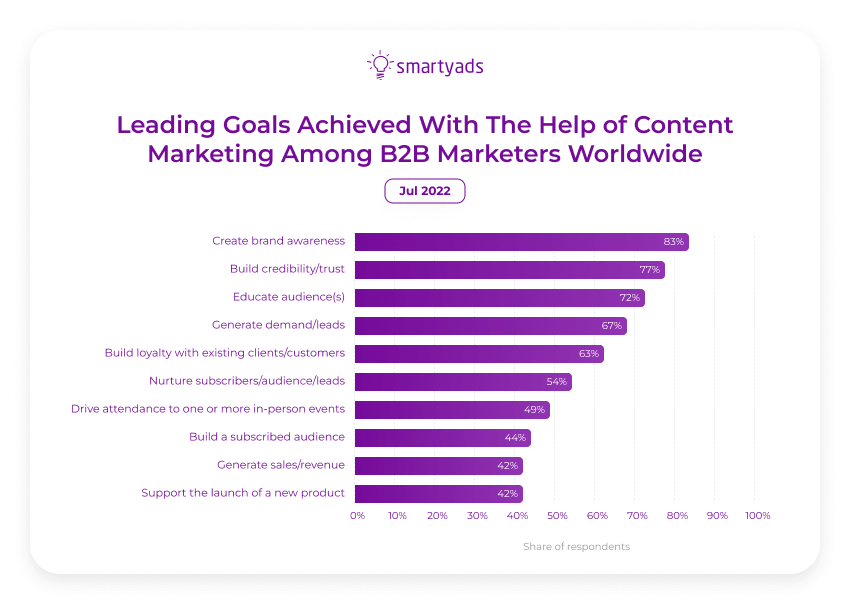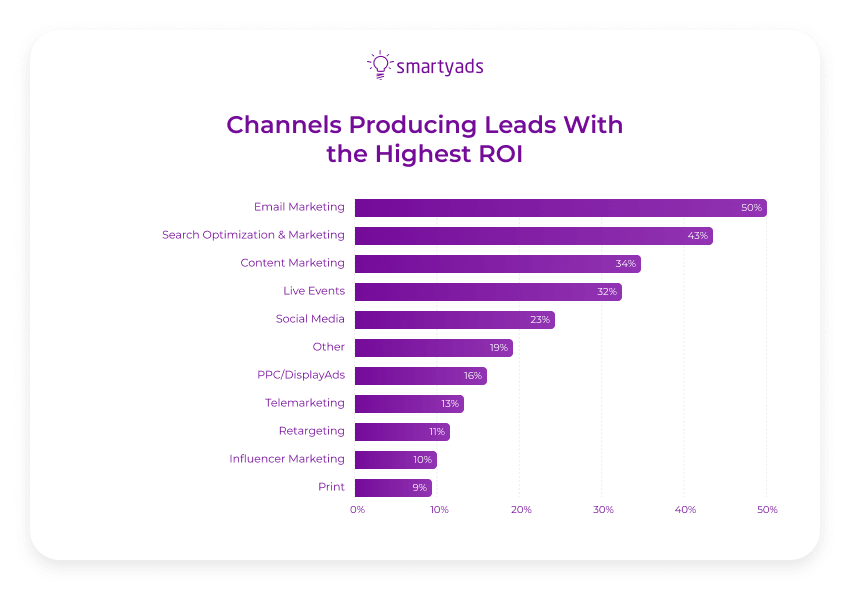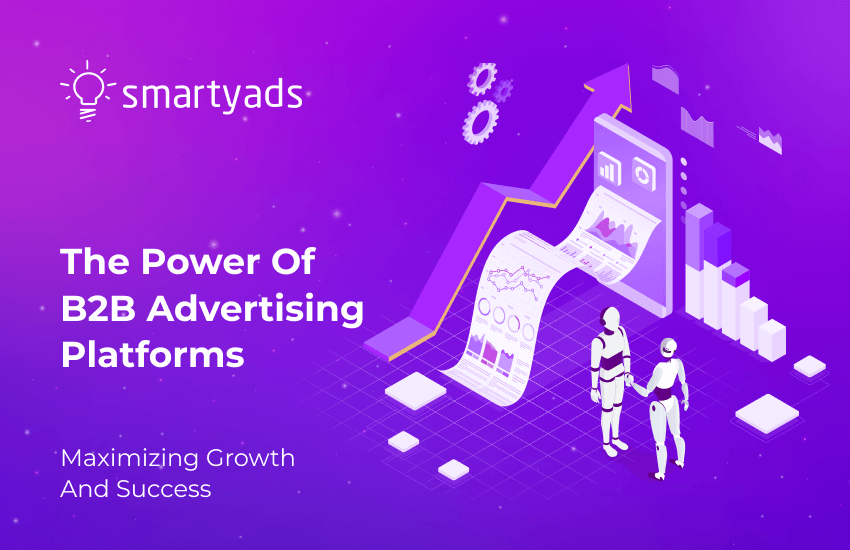Many people have the stereotype that advertising is poorly suited to attract customers in the B2B segment. It is important to understand that advertising in B2B is much more complicated than in B2C, and a simple setup in the frontal, in most cases, will not work, even if you know the toolkit of advertising platforms perfectly.
But B2B ad platforms are vital in the digital age, revolutionizing the way businesses market to one another. These platforms offer targeted reach, allowing companies to connect with specific industries and sectors. Businesses can stand out in a crowded digital landscape by enhancing visibility and brand awareness.

Lead generation tools capture valuable customer information, while data analytics enable optimization and measure campaign effectiveness. Streamlined communication and cost-effective solutions drive efficient marketing strategies.
Automation and personalization deliver relevant content, giving businesses a competitive edge. In summary, B2B ad platforms are essential for businesses to thrive in the digital realm, fostering connections, growth, and success.
Where to run B2B advertising?
If B2B advertising is a more complex form of marketing than B2C advertising, a logical question arises: where to run such advertising and how to use it. Let's first understand where the best place to launch a B2B advertising campaign is.
You can run B2B advertising campaigns on several platforms to reach your audience effectively.
Some popular options:
Social Media Platforms
LinkedIn, TikTok, Twitter, YouTube, Instagram, and Facebook are popular social media channels that provide comprehensive social media marketing features for targeting businesses and professionals. Among these platforms, LinkedIn stands out as a robust B2B advertising platform known for its extensive targeting options and a user base consisting primarily of professionals.
Search Engine Ads
Platforms like Google Ads and Bing Ads allow businesses to display paid ads in search engine results when users search for relevant keywords. These platforms offer keyword targeting, ad extensions, and other features to help businesses reach potential B2B customers actively searching for specific products or services.
Business Directories and Industry-Specific Websites
Online business directories and industry-specific websites can be effective platforms for B2B advertising. These platforms often have a highly targeted audience, allowing businesses to showcase their offerings to potential customers within specific industries or niches.
Content Marketing Platforms
Content marketing platforms, such as sponsored content on industry publications, can be valuable for B2B advertising. Publishing articles, whitepapers, or case studies on relevant platforms can help businesses establish thought leadership, increase brand visibility, and attract needed leads.
Email Marketing
Email marketing campaigns targeting brands and professionals can be highly effective for B2B advertising. Building a targeted email list and sending targeted messages to decision-makers and influencers within the target companies can yield positive results.
B2B Advertising Networks
B2B advertising networks, such as B2B display networks or programmatic advertising platforms, provide access to a network of websites and publishers specifically focused on B2B audiences. Such networks usually offer advanced targeting options and audience segmentation to reach the desired B2B demographic.
It's important to say that the choice of platforms depends on your audience, budget, and advertising goals. A comprehensive B2B advertising strategy may maximize reach and engagement with your target users.
B2B marketing with social media platforms
B2B social media marketing has been a hot topic of study over the past few years. Whereas B2B marketing used to be built primarily on personal connections and agreements, now B2B social media presence allows businesses to contact and communicate with each other from anywhere in the world if it can benefit both parties.
Here are the main factors to consider when implementing B2B social media marketing strategies for various platforms:
LinkedIn is the best social media platform for professionals and companies. Its robust B2B targeting options allows you to reach specific industries, job titles, company sizes, and more.
Utilizing LinkedIn ads allows you to effectively promote content, generate leads using lead forms, increase website traffic, and retarget visitors. With its professional-oriented environment, LinkedIn is an optimal platform for B2B marketing, allowing you to connect with industry decision-makers and professionals. This creates a favorable environment to establish meaningful connections and expand your reach within the B2B sector.
Twitter ads present valuable B2B advertising prospects to engage with diverse audiences. You have the ability to target specific hashtags, keywords, or even the followers of relevant accounts in your industry, enabling precise audience reach.
With various ad formats available on this platform, such as promoted tweets and accounts, you can enhance brand visibility, drive website traffic, and generate leads through increased engagement and click-through rates. Twitter provides an effective means to expand your B2B marketing efforts and connect with a wide range of potential customers.
Facebook and Instagram
Although Facebook and Instagram are predominantly associated with B2C advertising, they also provide opportunities for B2B advertising. These platforms offer advanced targeting options that allow you to reach professionals in specific industries or job roles based on various characteristics.
Facebook groups and Instagram ads can be particularly effective for boosting brand awareness, generating leads, and driving traffic to your website or landing pages.
Each of these social media platforms has its own strengths. Selecting the most suitable B2B social media network depends entirely on your specific goals and the potential partners you wish to target. For example, on Instagram, it's easier to find representatives from the beauty industry, while Facebook is more likely to have representatives from less image-independent brands.
B2B Marketing on Search Engine Platforms
When it comes to B2B advertising on search engine platforms, the primary options are the Google Ads platform and the Bing Ads platform. These platforms provide robust advertising solutions and reach a huge audience of users actively searching for products, services, and information. Here's a breakdown of where to advertise within these search engine platforms:
Google Search Ads
Google Search Network. This is the most famous and essential advertising option on Google Ads. Your ads will appear as sponsored listings within the Google search results page when users search for specific keywords or phrases related to your company. This network allows you to generate leads from B2B professionals across a wide range of marketing platforms and locations.
Google Display Network. Google Ads platform helps you to reach B2B audiences on websites, blogs, and apps that are part of Google's extensive network. These display ads can be in the form of banners, text, or other, and they are targeted based on user demographics, interests, and contextual relevance.
Bing Ads
Search Network. Bing Ads, Microsoft's advertising platform, is responsible for powering search results on Bing and Yahoo search engines. Leveraging the Bing Search Network, you can effectively connect with B2B professionals who rely on these search engines for their queries. With Bing Ads, you gain access to a range of targeting options comparable to those offered by Google Ads. This enables you to concentrate your advertising efforts on specific niches, GEOs, and keywords, maximizing your reach and relevance in the B2B market.
Microsoft Audience Network. Bing Ads also provides access to the Microsoft Audience Network, which includes premium partner websites, MSN, and Microsoft Edge. These platforms help you to extend your reach beyond search results and connect with B2B audiences through display ads.
To maximize the effectiveness of your B2B marketing on search engine platforms, it's recommended to conduct keyword research, create compelling ad copy, use ad extensions, and continually optimize your paid advertising campaigns based on performance data. By actively monitoring and refining your targeting parameters and bidding strategies, you can effectively reach the appropriate B2B audience and successfully accomplish your advertising objectives.
Content Platforms for B2B Marketing
Content marketing is a very broad concept; it includes many different platforms and people. Content marketing can be closely related to social media marketing, or it can be part of a search engine optimization strategy. That is why listing the platforms for this type of lead is very difficult. Let's focus on the groups of resources on which you can start your B2B marketing.
Industry Publications
Identify respected industry publications that cater to your target audience. These could be trade magazines, online journals, or niche websites focusing on specific sectors or themes relevant to your business. Advertising in these publications allows you to reach a highly targeted audience interested in industry-specific content.
Business Blogs
Look for influential business blogs that attract a significant following within your industry. Such blogs often cover a range of business-related topics and provide valuable insights to their readers. Advertising on such platforms can help you gain visibility and credibility among your target audience.
Specialized Websites
Explore specialized websites that focus on specific aspects of your industry or offer resources and information relevant to your B2B marketing strategy. These could be platforms dedicated to specific technologies, services, or business functions. Advertising on these sites allows you to reach a concentrated audience interested in specific areas within your industry.
Webinars and Podcasts
Collaborate with popular webinars or podcasts within your industry to advertise your products or services. These platforms often have engaged audiences seeking educational content or industry insights. Sponsorship or ad placements during these webinars or podcasts can help you reach a captive audience and establish thought leadership.
Online Forums and Communities
Identify online forums, discussion boards, or communities where professionals in your industry gather to share knowledge and insights. Advertising within these platforms can allow you to engage directly with your target audience and position your company as a helpful and trusted brand.
Social Media Platforms
Participate in or advertise within relevant specific social media groups or communities. Social Media Platforms like LinkedIn, Facebook, and Reddit have groups where professionals discuss industry topics and seek advice.
Utilizing advertising within these groups enables you to connect effectively with a highly targeted audience and encourage direct engagement.
Email for B2B marketing
Email marketing is one of the most effective ways to get new leads.

In the world of B2B marketing, there are several ways to get coveted email addresses:
Subscriber List. Start by leveraging your existing subscriber list. These contacts have willingly provided their email addresses and expressed interest in receiving updates, promotions, or content from your business. Craft targeted email campaigns catering to their needs, pain points, and interests.
Website Sign-Up. Utilize your website as a means to capture email leads. Place strategically designed sign-up forms or pop-ups that offer something of value, such as exclusive content, discounts, or access to webinars. Encourage website visitors to subscribe to your email list and stay connected with your brand.
Content Upgrades. Embed opt-in forms within your content, such as blog posts, whitepapers, or case studies, offering additional resources or extended versions of the content in exchange for email addresses. This approach helps to capture leads who have shown interest in your specific content offerings.
Webinars and Events. Promote your webinars or events through email marketing. Use targeted email campaigns to invite prospects and customers, highlighting the value and insights they can gain by attending. Follow up with post-event emails to nurture leads and provide additional information or resources.
Lead Generation Campaigns. Run dedicated lead generation campaigns to acquire email addresses. This can involve creating landing pages with compelling offers, such as free trials, demos, or consultations, in exchange for contact information. Use email automation to deliver the promised content and continue nurturing these leads.
Advertising Networks for B2B marketing
When it comes to ad networks, we can't help but talk about programmatic platforms that allow you to run B2B lead generation ads efficiently with minimal effort.
The term programmatic platforms may sound unfamiliar to you, but you've definitely seen it before, even if you didn't know it yourself. For example, Google Search Network is also a type of programmatic platform.
Programmatic advertising networks, such as Demand-Side Platforms (DSPs) and Supply-Side Platforms (SSPs), facilitate the automated buying and selling of digital advertising inventory. These platforms use data-driven targeting and real-time bidding to connect B2B advertisers with relevant publishers or websites that cater to B2B audiences.
These platforms facilitate the buying and selling of digital ad inventory through real-time bidding (RTB) and advanced targeting capabilities. Here are some popular programmatic platforms for B2B marketing:
Demand-Side Platforms (DSPs). DSPs are used by advertisers and agencies to programmatically purchase ad inventory across multiple ad exchanges and supply sources. Such platforms offer sophisticated targeting options, such as demographic, geographic, and behavioral targeting, allowing B2B marketers to reach specific audience segments with relevant messaging. DSPs also provide real-time analytics and optimization features to enhance campaign performance.
Supply-Side Platforms (SSPs). SSPs enable publishers and website owners to monetize their digital ad inventory by connecting with advertisers and DSPs. B2B marketers can access quality B2B inventory through SSPs, reaching business professionals on industry-specific websites and publications. SSPs often offer tools for inventory management, yield optimization, and real-time bidding, ensuring efficient delivery and monetization of ad impressions.
Data Management Platforms (DMPs). DMPs collect, store, and analyze large audience data sets, providing valuable insights for targeting and personalization. B2B marketers can leverage DMPs to better understand their target audience, create custom audience segments, and deliver more tailored and effective advertising messages. DMPs also allow data integration with other programmatic platforms to enhance campaign performance and audience targeting.
Ad Exchanges. Ad exchanges serve as marketplaces for buying and selling ad impressions in real time. B2B marketers can access a wide range of ad inventory across multiple publishers and websites through ad exchanges. These platforms use RTB to auction off ad impressions, allowing advertisers to bid on specific impressions that match their target audience criteria. Ad exchanges provide transparency, control, and scale for B2B programmatic advertising.
Account-Based Advertising (ABA) or Account-Based Marketing Platforms. ABA platforms focus on targeting specific accounts or companies rather than individual users. These platforms use data and technology to identify and engage key decision-makers within target organizations. B2B marketers can leverage ABA platforms to deliver personalized and account-specific ads across multiple channels, ensuring focused engagement with high-value prospects.
We at SmartyAds, have all of the above platforms. Regardless of your B2B marketing goals, you can use our platforms to achieve them.
Bottom Line
Your B2B marketing team needs B2B advertising because it has become a powerful tool for businesses, enabling them to maximize growth and achieve success in their marketing efforts.
By leveraging the capabilities of these platforms, businesses can efficiently target their audience, deliver personalized messaging, and optimize campaigns for optimal results. Embracing B2B ad platforms is essential for staying competitive in the digital age and unlocking the potential for accelerated growth and long-term success.
Run effective B2B advertising with SmartyAds!




